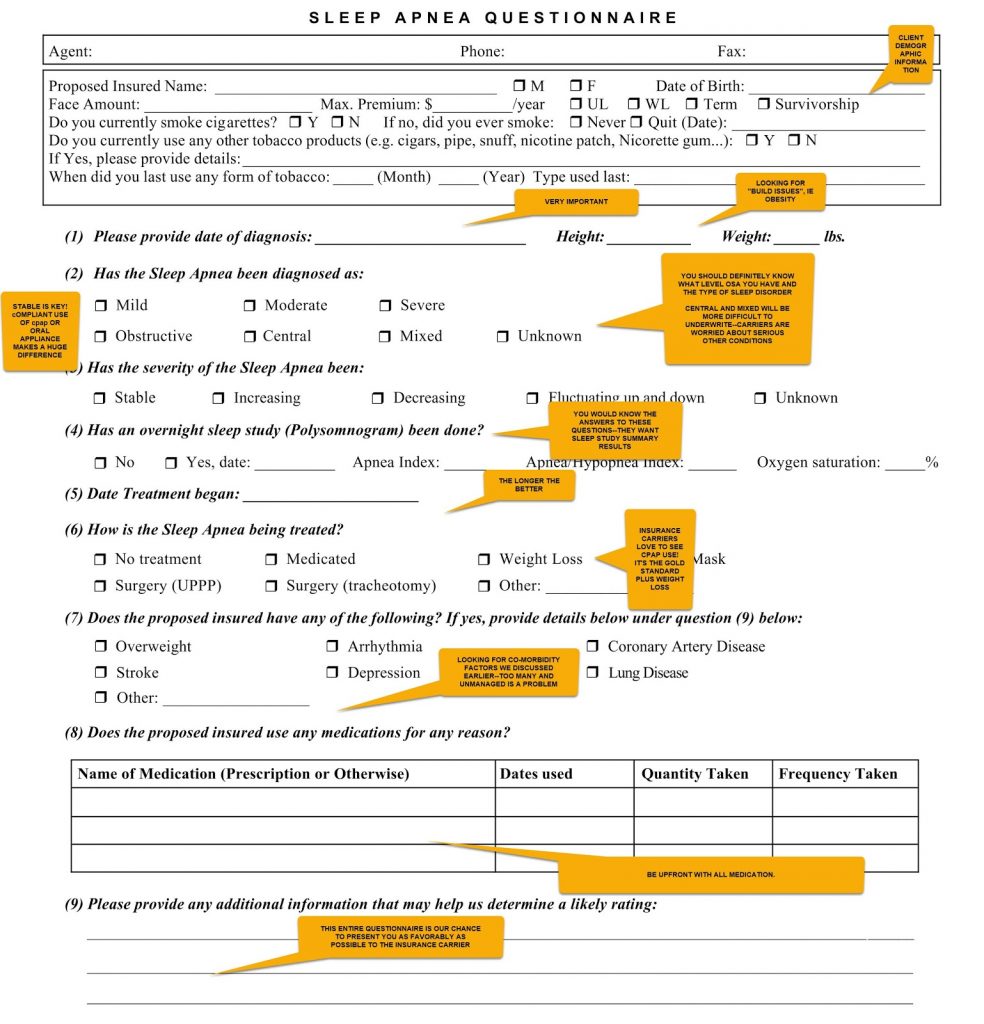
Living With Sleep Apnea Can Be Frustrating
No matter if your condition is severe or mild, living with sleep apnea can be a serious struggle.
And you’re not the only one who suffers. You partner may strongly dislike sleeping next to a human freight train, or otherwise known as a person with sleep apnea. (Ahem, guilty freight train partner speaking!)
Plus, living with sleep apnea often means getting quoted really crummy term insurance rates. Which, can impact your entire family not to mention your overall quality of life.
Let’s face it, not even the hum from a CPAP machine can drown out the “kerplunk” of money you may put towards your premium.
However, take heart in knowing that you’re not as powerless as you may think.
The Most Important Thing Underwriters Look For
In deciding what insurance rating to assign you, underwriters are bombarded with loads of information to process.
Your family’s health history, age, tobacco use, and weight are a few examples.
Yet, even in the middle of reviewing these intricate details of your life, an underwriter is looking for one main, “big picture” element.
Health management.
Underwriters want to know how you are managing your health. Naturally, when you’re living with sleep apnea, they’ll be inspecting how well you’re managing the sleeping disorder.
Life insurance companies all want to see successful treatment.
This includes an initial sleep study as well as a follow-up titration study needed correct pressures for your CPAP/BiPAP equipment.
The insurance company would also love to see some weight loss as well. Obesity is a significant co-morbidity with OSA.
Why?
Basically, an underwriter knows that people with sleep apnea who actively manage the condition tend to live healthier and longer lives.
A sleep apnea patient is typically very aware of his/her own condition and symptoms. Think about this for a moment.
We all live with daytime sleepiness, we stop breathing when we sleep, we never have trouble falling asleep. In fact, it’s quite the opposite. Literally, 54 million Americans have this disorder and the CDC doesn’t call it an epidemic.
Here is an example of a sleep apnea questionnaire. Clearly, you can see how detailed it is as well as what information an underwriter is placing under the microscope.

With this questionnaire in mind, here are 7 tips on how to convince an underwriter to quote you the best rates.
1. CPAP Compliance for Insurance
No matter if you deal with severe, moderate, or mild sleep apnea, medical professionals recommend the use of a CPAP machine. CPAP is the gold standard of OSA treatment.
Living with sleep apnea means your lungs start and stop automatically while you’re asleep. Unsurprisingly, this does little for your goal of getting a good night’s rest.
When you fail to get adequate rest, your performance suffers. It becomes dangerous for you to partake in many everyday activities such as driving.
Furthermore, sleep deprivation can cause a rapid decline in cognitive function (memory, problem-solving skills, communication, etc).
And that’s just for starters.
An underwriter knows all of this. So, when they see that you’re practicing CPAP compliance, they’re more likely to dole you out a better insurance rating.
Still not sure about CPAP compliance? Check out this post: CPAP Compliance for Insurance.
2. Other Treatment Options
Although the treatment of choice for people with sleep apnea is usually CPAP, there are other options.
This is especially helpful for those living with sleep apnea who are unable to use a CPAP machine.
Dental appliances exist which serve to reposition both the tongue and the lower jaw, making uninterrupted breathing easier.
A colleague, Dr. Lydia Sosenko in Illinois,has devoted much of her dental career to sleep apnea and oral appliances.
To learn more about how this non-invasive treatment works, go to her resource page here.
A nasal expiratory positive airway pressure (EPAP) device is another therapeutic option. Although EPAP has not been widely accepted as effective.
In short, this treatment method requires people with sleep apnea to cover their nostrils with a disposable valve.
Ultimately, a nasal EPAP device can create positive airway pressure when you exhale, opening up the airways during the next inhale.
Lastly, hypoglossal nerve stimulation is also a treatment method. As you may know, your tongue movement plays a large role when it comes to sleeping conditions.
This method works to stimulate your tongue muscles during sleep, promoting an open airway. By implanting a stimulator in your chest, medical professional attempt to communicate with the hypoglossal nerve that controls tongue movement.
3. Psychotherapy For Treating Sleep Disorders
Living with sleep apnea often means living with other issues as well. Including mental health concerns. There is evidence that certain sleep disorders, including sleep apnea, can be effectively treated by psychotherapy.
Sleep apnea suffers also typically have a greater incidence of mental health conditions.
What this means is that if you’ve survived any type of traumatic experience in your life, you’re more prone to dealing with sleep apnea.
Keep in mind that a traumatic experience doesn’t necessarily have to be warfare, natural disaster, or something gargantuan, per se. There is what mental health experts call little “t” traumas.
Experiences such as divorce or separation, losing a loved one, physical illness, or a toxic work environment can all fall under this category.
If you deal with anxiety or negative underlying emotions, seek professional help. It may pay off more than you can imagine as psychotherapy is viewed as a proactive treatment for your overall health.
Tip: You can typically include psychotherapy treatment on your sleep apnea questionnaire in the “Additional Information” section.
4. Improve Overall Lifestyle
Yes, this is the part where I talk about eating clean, drinking lots of water, and exercising.
Here’s the thing about improving your lifestyle for sleep apnea, it’s not as complicated as it seems. Plus, establishing small, sustainable habits in your life can speak loads to an insurance underwriter.
When you’re living with sleep apnea, you need that “one-up” on the healthy, marathon-running folks. Those premium rate-getting running machines aren’t slowing down whatsoever. In other words, the term “optimal health” is here to stay.
Still unsure of who gets what insurance rating? I review how insurance ratings are determined in this post: Is Sleep Apnea a Disability?
Really, you have to figure out how to make good health happen for you. Perhaps you won’t ever achieve the optimal standard. Yet, doing nothing will literally do nothing for your endeavor to land a great term insurance rate.
Living with sleep apnea means you can’t skimp on the basics of good health. Especially since the condition is doing all it can to rob you of the sweet sleep critical to obtain good health.
5. Decrease Stress and Anxiety
Along with improving your overall health, it’s important to look at the negative impacts on your daily life as well.
But let’s back up and talk about why it’s important. It’s undisputed that sleeping disorders and mental disorders are connected. Things like chronic stress and anxiety can put a huge damper on fulfilling rest.
Do you find yourself worrying a lot? Does anxiety keep you up at night? Do you wake up in the middle of the night with feelings of panic, unable to fall back to sleep?
Unfortunately, symptoms such as nocturnal panic attacks and worry-induced insomnia have all been linked to sleep apnea.
To improve your sleep, try improving your headspace. Identify what is causing your anxiety. Then, find actionable and practical ways to cope with it.
To take it a step further, find ways in your life to cut out unnecessary stress. Doing so will improve your life quality and possibly improve your insurance rating as well.
6. Opt for Surgery

Photo Credit: Majid Jamali, DMD • Oral & Maxillofacial Surgery of New York
Moving from your mental capacity to a more tangible element, surgery is another viable option for most people with sleep apnea.
There are three popular surgeries recommended for this sleeping condition
First Is Uvulopalatopharyngoplasty Or UPPP.
UPPP sleep apnea surgery involves the removal of the soft tissue at the back of the throat.
Sometimes, the additional soft tissue at the back of the throat is removed as well.
The Second Type Of Surgery Is Tracheotomy Or Tracheostomy
UPPP was more frequently used prior to the development of CPAP.
In this surgery, a medical professional creates an opening in your neck. This opening—either temporary or permanent—is used to place a tube into your windpipe, creating a direct airway.
Third Is Maxillomandibular Advancement (MMA) Surgery
MMA surgery is a highly invasive procedure but offers much better and long-lasting outcomes.
As you may know, people with sleep apnea encounter pharyngeal collapse when they’re asleep. MMA surgery works to increase the pharyngeal space by moving the upper and lower jaws. MMA surgery is highly invasive and involves a lengthy recovery, however, MMA surgery has an extremely high success rate. Quite easily the most intense surgery of the three, your upper and/or lower jaw are effectively moved forward to enlarge the airway.
Usually, all surgeries are mentioned on any sleep apnea questionnaire. They serve as a determining factor in an underwriter’s final decision.
7. Take A Proactive Approach To Genetic Health Issues
In the celebrity world, Angelina Jolie chose to undergo a preventive double mastectomy to decrease her risk of breast cancer. However extreme you may feel her choice was, it was undoubtedly an incredibly proactive approach.
Thankfully, your own proactive actions will be less like headline material and more like practical daily choices.
But, your underwriter may see your choices as “headline material.” especially if you’re diagnosed with sleep apnea.
A few examples taken directly from the sleep apnea questionnaire include obstructive sleep apnea OSA, lung disease, being overweight, arrhythmia, depression, coronary heart disease, and stroke.
When you know these issues run in your family, taking a proactive stance may sway an underwriter’s mind.
Rather than sitting back and letting genetics push you around, being proactive proves you’re on the offensive.
Essentially, you’re doing what you can to manage your health in the best way possible.
Make sure you discuss all your treatment options with a qualified sleep medicine specialist. They can help guide you and discuss all treatment options. They will, in effect, become your sleep quarterback.
If you want more information on sleep apnea resources, please go to the National Sleep Foundation. They have in-depth resources and an online community forum that is extremely helpful.
Qualifying for AWESOME insurance rates can seem impossible if you’re living with sleep apnea. By taking a few steps in the right direction you can win the very best rates!
For a more in-depth look at living with sleep apnea, please see my Buyer’s Resource Guide.
If you’re ready to get a top-term insurance rate, contact us today by phone at 650-969-5844 or email at [email protected].
Also, if you’d like to learn more about our local SF Bay Area presence, please go here.
